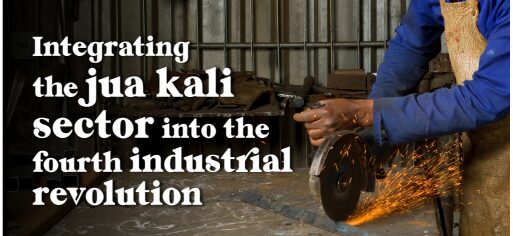Integrating the jua kali sector into the fourth industrial revolution

The informal labour market is a complex and multidimensional sector characterised by non-standard employment relationships and irregular work arrangements. In Kenya, the informal Jua Kali sector is an integral part of economic development. Low skills, low wages, lack of access to finance, and the safety of social networks characterise this sector. In a nutshell, the Jua Kali sector is a collection of traders and artisans in possession of a wide array of skills, among them metalwork, carpentry, plumbing, fabrication, tailoring, shoe repair, and automobile repair, among others. This sector is, therefore, not regulated or protected by the government and often operates outside the formal economy.
Informality in Jua Kali is often the cause of development challenges, especially in Emerging Markets and Developing Economies (EMDEs). This is due to relying on labour-intensive activities that employ unskilled workers who are poorly remunerated and lack fiscal resources.
The Jua Kali sector is a significant contributor to the country’s economy, accounting for up to 80% of overall employment (Kenya National Bureau of Statistics (KNBS, 2023)). The sector employs 14.9 million people and contributes to 77% of the total workforce in Kenya. Most of the workforce is young, with 60% aged between 18 and 35 years, and women (50%). Over one million Jua Kali artisans work and sell their wares on roadsides, contributing to 25% of the GDP(KNBS, 2018).
The sector’s role is not underestimated, as it not only creates jobs but also exports Jua Kali products to neighbouring countries, fetching foreign exchange for the economy. The adoption of the Fourth Industrial Revolution (4IR) technologies, particularly mobile platforms, can ease access to the market for informal workers in Kenya. In the modern world, digital marketplaces and mobile app development have increased connectivity, removed middlemen, and enhanced income opportunities for these workers.
The 4IR is causing the Jua Kali sector to harness new and emerging technologies to reach higher levels of efficiency in production and consumption. Employers are increasingly seeking workers with new skills from further afield to retain a competitive edge and expand workforce productivity. Some workers are experiencing rapidly expanding opportunities in new and emerging job roles, such as e-commerce entrepreneurs, digital marketing specialists, and recycling specialists, while others are experiencing a declining outlook in traditionally considered ‘safe bets’ and gateways to a lifetime career.
Interventions required for digitising the sector
Jua Kali workers can be empowered to unleash their entrepreneurial potential and pave the way for a more inclusive and prosperous future in the digital economy through:
- Access to finance and resources
Access to finance and resources is crucial for modernising the informal Jua Kali sector in the 4IR. Digital finance solutions like mobile banking, peer-to-peer lending platforms, and blockchain-based financial services can provide artisans with capital to invest in advanced technologies. Microfinance institutions and banks should develop tailored financial products with favourable terms and low interest rates to encourage tech adoption. Government grants and subsidies for integrating 4IR technologies, such as automation tools, 3D printing, and AI-driven systems, can empower Jua Kali businesses. Resource access should also include training and capacity-building programs, partnerships with tech companies, and shared innovation hubs with modern machinery and digital infrastructure. By ensuring the Jua Kali sector has the financial means and technical resources to embrace the 4IR, the government and private sector can foster a more competitive, efficient, and sustainable informal economy.
- Development of digital infrastructure to increase 4IR adoption
The 4IR necessitates the development of digital infrastructure to enhance the informal Jua Kali sector. Access to high-speed internet, digital marketplaces, online training, and advanced tools is crucial. Affordable internet services in urban and rural areas can bridge the digital divide, ensuring inclusivity. Digital hubs equipped with modern technology can modernise production processes, increase efficiency, and provide digital literacy training. Investment in cybersecurity measures protects businesses from digital threats. Prioritising digital infrastructure can drive innovation, expand market reach, and enhance economic resilience.
- Market access and e-commerce
The Fourth Industrial Revolution (4IR) has the potential to transform the informal Jua Kali sector by improving market access and leveraging e-commerce. Digital platforms and online marketplaces allow artisans to reach a global audience, facilitating customer engagement and increased sales. Training programs on digital literacy and e-commerce skills are crucial for artisans. Partnerships with established e-commerce companies can provide logistical support, while social media and digital marketing strategies can enhance visibility and brand recognition.
- Regulatory framework and support
The Fourth Industrial Revolution (4IR) necessitates an adaptive regulatory framework and comprehensive support system for the informal Jua Kali sector. The government should modernise regulations to accommodate digital business operations, simplify registration processes, and tax incentives for tech adoption. Training programs on digital skills, cybersecurity, and e-commerce platforms should be provided to ensure artisans are well-equipped for the digital economy. Establishing innovation hubs and providing access to digital infrastructure can enhance productivity and innovation. Policies protecting intellectual property rights and promoting fair digital trade practices are also crucial. By creating a supportive regulatory environment, the Jua Kali sector can harness the full potential of the 4IR, driving sustainable growth and competitiveness.

